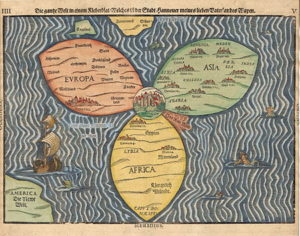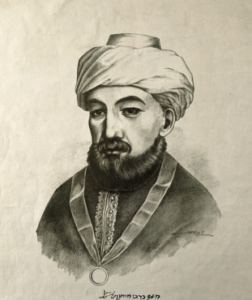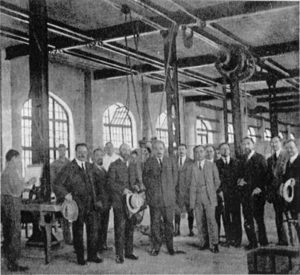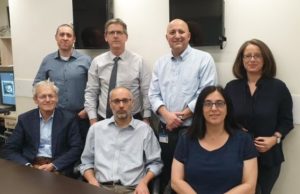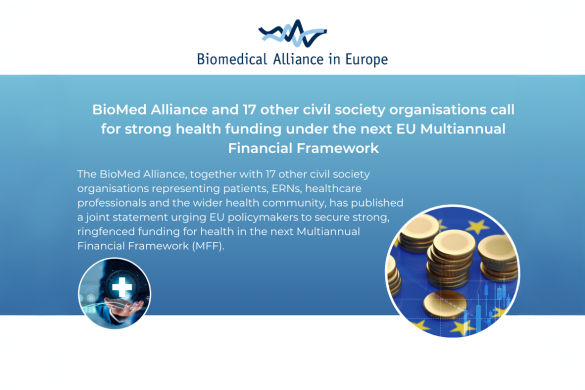Israel is located on the southeastern shore of the Mediterranean Sea and the northern shore of the Red Sea. With a population of 8.7 million inhabitants, it is a liberal democracy with a parliamentary system, proportional representation, and universal suffrage. The population is highly diverse including Israeli Jews (75% of population) of varied ethnicity, Israeli Arabs (~21% of population), and a spectrum of religiosity (secular, orthodox, and Haredi- ultra-orthodox). Israel is a member of the OECD. The country benefits from a highly skilled workforce, and it is among the most educated countries in the world, with one of the highest percentages of its citizens holding a tertiary education degree. Israel has the highest standard of living in the Middle East, and one of the highest life expectancies in the world. Furthermore, despite many turmoils, Israel ranked 11th in the UN’s 2018 World Happiness Report.
The city of Jerusalem, holy to people of faith the world over. Map of the world with Jerusalem at the center, Heinrich Bünting, “Iitinerarium Sacrae Scriptuare”, 1581
People of modern day Israel share the same language and culture shaped by the Jewish heritage and religion passed through generations starting more than 3,000 years ago. The cultural and religious seeds planted then kept Jewish communities through migrations, exiles, successful times, and massive historical changes around the world from 70 CE to the modern era. In the 19th century, the notion of – a state for the Jews – was first formulated, and in 1948, after World War II and the Holocaust, the State of Israel was established.
Maimonides (The Ramba’m; 1135 – 1204), a preeminent medieval Jewish rabbi, physician, and philosopher. He was among the first to propose that the health of the body and soul should be combined, planting the roots of modern preventive Neurology. He coined the Acronym in Hebrew for Health: Increase Exercise, Decrease Food, Avoid Anger.
The history of academic and medical development began well before Israel’s independence in 1948. The Technion, founded in 1912 with the firm support of Albert Einstein, has become a leading engineering university in Israel, and it has increased education and research for both engineering and life science. The Weizmann Institute of Science, founded two decades later in 1934, has also affected the development of life science companies by pioneering technology transfer, and founding an adjacent science-based industrial park that continues to evolve and interact with the research teams at the institute. Hadassah Medical Center was established in 1939 in collaboration with the Hebrew University of Jerusalem, and it was the first teaching hospital in Israel. The three large hospitals in the center of Israel, the Rabin Medical Center (founded in 1936), the Sheba Medical Center (founded in 1948), and the Tel Aviv Medical Center (founded in 1964) were all established as leading teaching hospitals affiliated with Tel Aviv University. Founded in 1938, the Rambam Medical Center is the major referral hospital for northern Israel. The Soroka Medical Center was established in Beer Sheva in 1956, and affiliated with the Ben Gurion University of the Negev. In 2011, a fifth medical school affiliated with several hospitals in the Galilee was established in Sefad by the Bar-Ilan University.
Prof. Albert Einstein, founder of the 1st Technion Society, on-site at the workshops of the historical Technion building
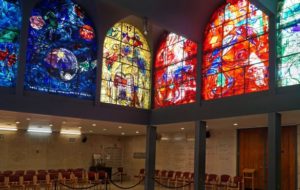
The Chagall Windows at the Hadassah Medical Center, Ein Kerem, Jerusalem
In the early years of modern Israel, a subsequently large influx of Jewish refugees, from post-war Europe (approximately 300,000 Holocaust survivors) and more than 700,000 refugees from the surrounding Arab countries, put an enormous strain on the new state’s health services, especially in the early 1950s. Recurrent waves of immigration have characterized Israeli history, with the health-care system being repeatedly buffeted by resultant, sudden, unexpected surges in demand, including a wave from Ethiopia in the 1980s onwards, and an influx of about 1,000,000 during the 1990s from the former Soviet Union. The growth of ten-times or more in the population of Israel in fewer than seven decades since its independence state has been an important catalyst for the impressive advances in many aspects of individual and population health, as well as medical education and research.
Via the promulgation of the 1994 National Health Insurance Law, all residents of the country receive health services on the basis of the principles of justice, equality, and mutual assistance, through a legally defined basket of health services, under the overarching responsibility of the state, and provided by four not-for-profit health plans. The health-care system in Israel recognizes no ethnic or religious boundaries, serving as an example of excellent collaboration between Israeli Arabs and Israeli Jews nationally. In 2015, Israel ranked sixth-healthiest country in the world by Bloomberg rankings.
A strong technology-oriented educational system, engineering resources and infrastructure have been developed in Israel. The Israeli incubator program was established in 1990, with the primary objective of transforming innovative technological ideas into viable start-up companies. Universities, research institutes, and health-care institutes have technology transfer offices (TTO) which serve a substantial role in the high-tech landscape in Israel. The strong relationship between the incubator program and the TTOs of the academic and medical institutions has had a key role in enhancing life science initiatives.
Israel has an innovative spirit and supporting ecosystem and a culture that values entrepreneurship. It has been recognized as the “Start-up Nation”, given that per person it has the highest rate globally of start-ups, of venture capital investment, and of medical equipment patents. Many of the technologies we all use originated from Israeli innovation. This ecosystem is translated also to the brain and neuroscience arena. Israeli medical device companies have integrated electronics, communications, electro-optics, lasers, navigation, robotics and artificial intelligence resulting in innovative solutions for medical problems. A landmark in the history of life science companies in Israel was the founding of Teva Pharmaceutical Industries in 1901 as a small private pharmacological company, which became a major player in the industry, specializing in generic drugs. Two of its blockbuster proprietary drugs, Copaxone and Rasagiline, originated from Israeli academic institutes.
A selfie by the lunar spacecraft Beresheet 22 kilometers from the surface of the moon. The commitment of the Israeli culture to inspire the next generation to study science and technology is well exemplified by the first non-profit private, high-tech low-budget collaboration spacecraft to orbit around the moon, which crash-landed during its final descent.
While enjoying a situation with relatively low health expenditures in the face of excellent health indices, some services are seriously underfunded, such as the number of acute hospital beds and the number of health professionals per capita. There are over 300 neurologists at working age in Israel, which equates to approximately 4 neurologists per 100,000 people. There are 17 academic neurology hospital departments in Israel, and additional neurological units. The Ministry of Health has a successful National program for quality indicators in which acute stroke management is prominent and there is a national stroke registry. To become a neurologist, one has go through a five-year specialist training position, and a 2-step board examination, under the supervision of the scientific council of the Israeli Medical Association. There are also 1-year fellowship programs in the main Neurology sub-specialties. Numerous Israeli neurologists have contributed to the advancement of international neurology, with leading organizational roles.
The first EAN Day in Israel took place in December 2018 and was a great success.
Prof. David Tanne is the president of the Israel Neurological Association, which has approximately 500 members. The annual conference takes place in December, and last year it was preceded by a very successful EAN workshops day. The Israel Neurological Association holds workshops for residents for preparation for step I and II board exams in Neurology and for deepening neurological skills. The Brain Fair is an annual public event recently established by the Israeli Neurological Association to increase awareness to the wonders of the brain in health and sickness. In a 2015 analysis of gross neurological product per inhabitants (GNP; a metric of the number of peer-reviewed studies on neurological topics) Israel ranked # 8. Given the increasing burden of Neurological disorders and the challenges and opportunities facing Neurology in Israel, the Israeli Neurological Association has embarked on an initiative to increase awareness to Neurological disease and to strengthen Neurology and promote the opportunities to decrease the burden of Neurological disease.
Prof. David Tanne, The president of the Israeli Neurological Association and part of the board.
By Prof. David Tanne, Director, Stroke and Cognition Institute Rambam Health Care Campus, Haifa and President of the Israeli Neurological Association
Mrs Michal Klein, Administrator, Israeli Neurological Association

